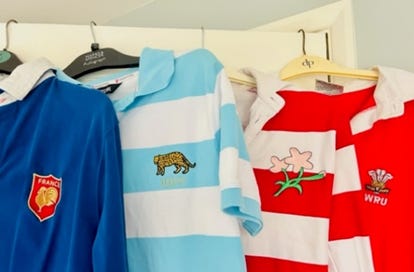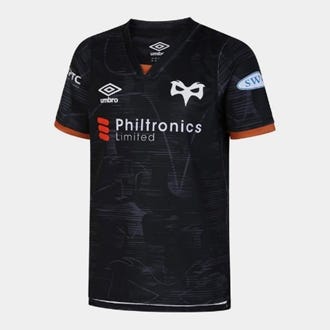Sunday Read: The Anatomy of a Rugby Kit Deal - Part 1
Huw takes a deep dive into how kit manufacturers win deals with clubs and the risks taken in the quest for profit
The following is a re-post of our first ever Substack article. Now that we have a slightly larger following, we thought it would be fun to give it another outing. Hope you enjoy!
I have Started collecting rugby merchandise. It’s a fun vice to have, a harmless way of spending any disposable income that brings me joy and allows me to express my love of the sport as a non-match-going fan.
I’m always on the lookout for a nice example to pick up next time the pay cheque comes through, but my collection continues to have one curious omission – I do not own any jerseys of any of the Welsh regions.
These are the teams I watch more than any other, who’s performance I am possibly the most invested in, who I am most a fan of. So why haven’t they been able to part me with my money?
Well, a glance at the current offerings yields an answer. When compared to what’s available from other clubs, the Welsh regions merchandising can be pretty uninspiring.
The likes of Stade Francais, Moana Pasifika and Harlequins offer vast arrays of merchandising in bright colours that can be worn to any occasion. The Welsh regions sometimes can only offer a replica shirt and a grey hoodie.
This perceived disparity has left fans frustrated. Jamie, a Dragons fan, says there’s a “lack of imagination going into the home kits. It’s very bland and looks too similar to the Ospreys kits. They should be bolder.”
“Also, the fact you can’t buy the merch anywhere other than the club shop and website is rather restrictive.” Jamie continues, “I actually think all the regions’ merch should be available to buy in Sports Shops in Wales.”
Harley, a Cardiff fan, points to a lack of diversity in the products. “I think teams need to do better stash overall more odd items like wallets bags heck even maybe phone cases… I'd love a vest for running/if I go back to rugby training and some shorts.”
He says he mostly likes Macron’s merch but finds their sizing to be frustrating. He suggests Suppliers should “give up on the match replica jersey… go to a more flattering style of supporter jersey paired with a nice cotton replica.”
So how did we get here? I wanted to educate myself more about how kit deals work, how merchandising strategies are determined and what, if anything, keeps the regions from offering a wider range of products that fans may find more appealing.
I got the chance to speak to someone high up in one of the regions about club retail, the business of merchandising and product strategy. Here is what I learned…
The Business of Kit Deals
The first thing to note is that there aren’t as many kit suppliers for sports teams as there used to be. Fans have prejudices about some suppliers – based on past experiences – that lead them to make their mind up very quickly on new kit deals.
However, certain traditional suppliers such as Underarmour and Canterbury are doing fewer and fewer team sports, due to the lack of profitability in most cases (which we will come onto), hence more teams moving to newer brands such as Castore and Macron
There can be 2 types of deals: a) the supplier sells the merchandise, and the club gets a cut of each unit sold, or b) the supplier pays the club a lump sum for the forecast value of the deal and only pay more if sales go above a certain threshold.
A supplier may bring a number of perks to the deal. They may offer to take over all retail on behalf of the club, meaning the club doesn’t take on the expense of running that side of the business. They may also have brick & mortar stores in cities that the club could never afford to set up themselves, putting the club and its merchandise in front of more eyes and making it more accessible for some customers.
Kit suppliers also have different in-house capabilities. They may have stock ‘blank’ kits in different colours, meaning when a certain customer orders a certain kit, all they need to do is embroider the correct logo and ship it out, thus broadening potential offerings and cutting down process times.
Some clubs also have wider deals that they are a part of. For example, New Zealand Rugby have a deal with Adidas to supply the All Blacks, black ferns and 5 super rugby franchises all together, meaning the deal is worth more and can attract a more lucrative contract. Scotland Rugby also have all 4 teams (mens’, women’s, URC teams) supplied by Macron whilst all MLR sides in America are supplied and retailed by a company called Paladin.
The Money
Let’s talk about money. Selling merchandise might seem like a guaranteed way of making money. Many youtubers and musicians, for example, make almost the entirety of their living off merch sales. For example, Logan Paul’s ‘Maverick’ range of clothing merchandise makes him tens of millions a year.
However, sports merchandising can be a different story. Even premier league football teams, with huge global reach, turn over £4-5m a year from retail – around 60% of which is kit sales.
The margins on the kits, for the clubs at least, are less than you would think. Of the retail price of a jersey, 60% will be the cost the club pays the supplier, whereas it may only cost the supplier 20% of the retail cost to produce.
There are then the quantities involved. A typical minimum order a supplier would demand is around 100 units per size (S/M/L/XL/XXL…). So, a club is already building up inventory from the start. Anyone from an engineering background will tell you: inventory is a form of waste.
Furthermore, once the deal is signed, that chosen supplier normally has exclusive rights to all of the clubs merchandising. You cannot, for example, have Nike supply the replica jerseys and Canterbury make the retro jerseys.
Product selection is not straightforward and there are no guarantees a product will sell. If a club over-buys stock, at the end of the financial year it has to be written off and it will appear on the books as an asset that has lost the majority of its value.
The cost is also in the manning of the retail team. A lower end English Premier League side may have a retail team of about 12. Due to budget restrictions, a Welsh region may just have a couple of heads. This also limits the scope of what merch projects can be undertaken.
These financial considerations are known as ‘risk’ and, in the current climate, the regions can only afford to take on so much risk. Hence, a region may be attracted to a deal where the supplier takes on the retail for them, meaning they have offloaded the risk to that supplier.
Next: Check out Part 2: Part of the Crew












Those Welsh ones are pretty dreadful.
I've noooo idea who Logan Paul is